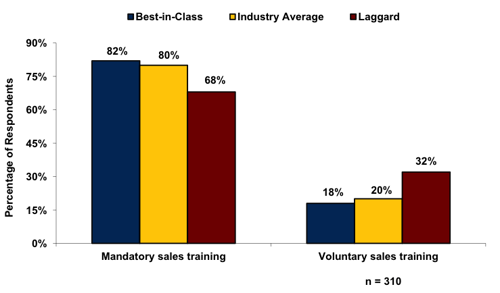Sales Training: 5 Action Items You Need to Implement Now


My goal is to share best practices and proven, performance-enhancing tactics that Aberdeen’s five-year Sales Training research data have consistently showcased as worth adopting by forward-leaning sales leaders. In this blog, I share five specific sales training related action items which you can immediately implement in order to achieve the kind of results that Best-in-Class sales organizations enjoy.
1) Remember that “those who fail to learn from history are doomed to repeat it.”
This lofty phrase is merely intended to make sure you don't forget the valuable lessons of the previous blogs in this series:
- It is very easy to make an ROI case to senior management for aggressive sales training investments. The research data are all in your favor.
- Call Planning is perhaps the most crucial element of sales training. Everything boils down to the live conversation between buyer and seller; you cannot over-emphasize the value of preparation.
- Replace cold calling with meaningful conversations. Understanding the needs of the buyer is not optional.
- Get social. Learn from the Best-in-Class how to collaborate, listen, and participate… Or fail.
2) Make a Stand
Make a stand regarding sales training as an absolute necessity for your organization's success. Figure 1 is clear: the vast majority of companies require their sales reps to participate in formal sales training, and especially so among the Best-in-Class:
Figure 1: Mandatory vs. Voluntary Sales Training

Source: Aberdeen Group, September 2012
These top performers are also more consistent about providing sales training, with 87% of reps receiving regular training, compared with 81% of reps in Industry Average firms and only 67% among Laggards.
Additionally, Best-in-Class sales organizations provide an average of 3.14 hours of formal training per rep, per month — 26% more than the 2.5-hour average reported by Laggards. This provides a compelling argument against the idea that training time is less valuable than selling time.
3) Change your corporate DNA
Change your corporate DNA to enforce sales training as an ongoing function rather than a one-time event. Fully 80% of Best-in-Class companies – defined as those with the most reps achieving quota, and the best annual improvement in growing revenue and deal size — indicate that they “provide post-training reinforcement of content presented in initial educational sessions,” compared with 57% among All Others.
Post-training reinforcement of original training content remains a consistently strong knowledge management capability in Aberdeen's sales training research. Most survey respondents, particularly the Best-in-Class, realize that even the most conscientious training participants are likely to drift back into old habits after initial training. Reminders of key takeaways and lessons learned, especially if presented in smaller, digestible servings, can reinforce concepts those reps can apply to real world sales situations.
4) Embrace Technology
While traditional, instructor-led training remains highly popular among all survey respondents — 90% of the Best-in-Class and 81% of All Others deploy it — the vast array of technology at the disposal of sales leaders create a wide variety of opportunities to address the reinforcement needs described above in a more virtual environment. Whether deploying a formal mobile learning application that reps can access in an "anytime, anywhere, any device" field sales environment, or simply sending sound-bite reminders of sales best practices via e-mails, the sales ops team needs to consider digital learning as a must-have, not a nice-to-have, element of their sales talent management roadmap.
5) Get Personal
Get personal with your sales training implementation. There's a reason why 59% of Best-in-Class sales organizations report the acquisition of “customized coaching from third-party providers that is specific to our company or even individual sales opportunities,” compared with 42% of Industry Average and only 29% among Laggard organizations.
While it is not entirely untrue that certain sales methodologies, tactics, and even scripts can be effective across different industries and selling situations, these data — as well as common sense — dictate that the smart money around sales training is better spent on hiring a professional team that will spend the time understanding the particular needs of your market and product … not unlike the solution-selling guidance underscored above.
When they design a customized program, and support it with ROI metrics you can use to determine its long-term effect on your top line, make sure that a train-the-trainer element is included in the engagement. Creating an ongoing culture of sales best practices, based on incorporating this tribal knowledge into the very marrow of your sales effectiveness strategies, will all but guarantee Best-in-Class results for your team.